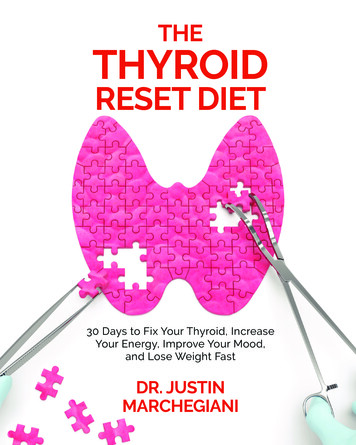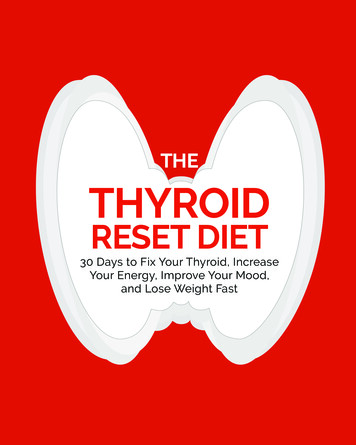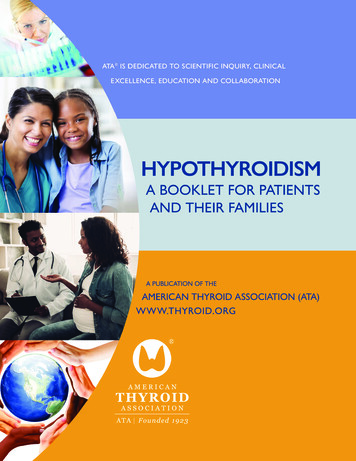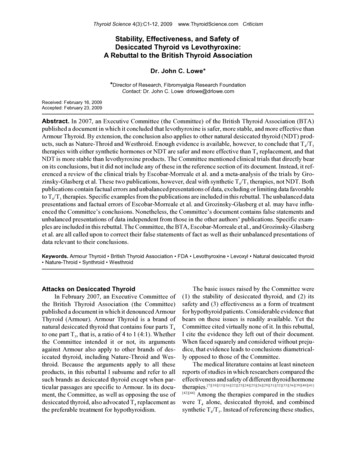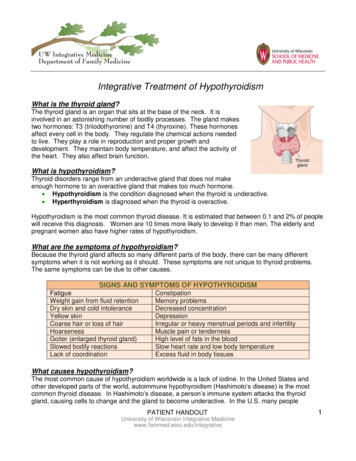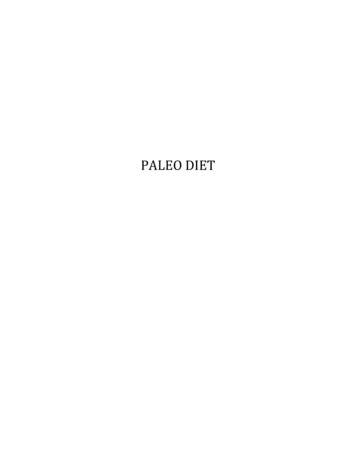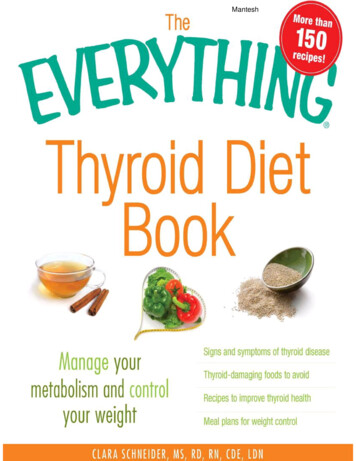
Transcription
Mantesh
THEEVERYTHING THYROID DIETBOOKManteshManage your metabolism and control your weightClara SchneiderMS, RD, RN, CDE, LDN
ManteshCopyright 2011 by F W Media, Inc.This book, or parts thereof, may not be reproduced in any form without permission from the publisher; exceptions are made for briefexcerpts used in published reviews.An Everything Series Book.Everything and everything.com are registered trademarks of F W Media, Inc. Published by Adams Media, a division of F W Media, Inc.57 Littlefield Street, Avon, MA 02322 U.S.A.www.adamsmedia.comThe Everything Thyroid Diet Book contains material adapted and abridged from:The Everything Calorie Counting Cookbook by Paula Conway, copyright 2007 by F W Media, Inc., ISBN 10: 1-59869 416-2;ISBN 13: 978-1-59869-416-1.The Everything Diabetes Cookbook, 2nd Edition by Gretchen Scalpi, copyright 2010 by F W Media, Inc., ISBN 10:1-44050-1548; ISBN 13: 978-1-44050-154-8.The Everything Gluten-Free Cookbook by Nancy T. Maar and Nick Marx, copyright 2005 by F W Media, Inc., ISBN 10: 159337-394-5; ISBN 13: 978-1-59337-394-8.The Everything Guide to Being Vegetarian by Alexandra Greeley, copyright 2009 by F W Media, Inc., ISBN 10:1-60550-051-5;ISBN 13: 978-1-60550-051-5.The Everything Guide to Macrobiotics by Julie S. Ong, copyright 2010 by F W Media, Inc., ISBN 10: 1-44050-371-0; ISBN 13:978-1-44050-371-9.The Everything Low Cholesterol Cookbook by Linda Larsen, copyright 2007 by F W Media, Inc., ISBN 10: 1-59869 401-4; ISBN13: 978-1-59869-401-7.The Everything Low-Salt Cookbook by Pamela Rice Hahn, copyright 2004 by F W Media, Inc., ISBN 10: 1-59337-044 X; ISBN13: 978-1-59337-044-2.The Everything Soup Cookbook by B. J. Hanson and Jeanne Hanson, copyright 2002 by F W Media, Inc., ISBN 10:1-58062-5568; ISBN 13: 978-1-58062-556-2.The Everything Sugar-Free Cookbook by Nancy T. Maar, copyright 2007 by F W Media, Inc., ISBN 10: 1-59869-408-1; ISBN13: 978-1-59869-408-6.The Everything Whole Grain, High Fiber Cookbook by Lynette Rohrer Shirk, copyright 2008 by F W Media, Inc., ISBN 10: 159869-507-X; ISBN 13: 978-1-59869-507-6.ISBN 10: 1-4405-1097-0ISBN 13: 978-1-4405-1097-7eISBN 10: 1-4405-1155-1eISBN 13: 978-1-4405-1155-4Printed in the United States of America.10 9 8 7 6 5 4 3 2 1Library of Congress Cataloging-in-Publication Datais available from the publisher.The information in this book should not be used for diagnosing or treating any health problem. Notall diet and exercise plans suit everyone. You should always consult a trained medical professionalbefore starting a diet, taking any form of medication, or embarking on any fitness or weight-trainingprogram. The author and publisher disclaim any liability arising directly or indirectly from the use ofthis book.This publication is designed to provide accurate and authoritative information with regard to thesubject matter covered. It is sold with the understanding that the publisher is not engaged in renderinglegal, accounting, or other professional advice. If legal advice or other expert assistance is required,the services of a competent professional person should be sought.
— From a Declaration of Principles jointly adopted by aCommittee of the American Bar Association and a Committee ofPublishers and AssociationsMany of the designations used by manufacturers and sellers to distinguish their products areclaimed as trademarks. Where those designations appear in this book and Adams Media was awareof a trademark claim, the designations have been printed with initial capital letters.This book is available at quantity discounts for bulk purchases.For information, please call 1-800-289-0963.
THE EVERYTHING THYROID DIET BOOKDear Reader,It is my pleasure to write The Everything Thyroid Diet Book. As a registered/ licensed dietitian,nurse, and certified diabetes educator, I have had many patients with different types of thyroiddisease. On a personal level, dealt with Hashimoto's disease for more than twenty years. In the pasttwo years I have developed celiac disease. I also am dealing with the effects of sclerodermamorphea, which is another autoimmune disease that I have had for more than fifteen years. Manypeople with autoimmune diseases have more than one. I know, I have three.I have many resources available to me because of my occupation, but still found it difficult at timesto manage my diseases. As a very compliant patient, I have swung from hypothyroidism tohyperthyroidism as I was gaining control of my celiac disease, and my nutrition as well as mymedications were better absorbed. I now have gained control of my health and wish to share with youmany of the things that I have learned.Thyroid disease will always be a big part of my life. As I wrote this book, I learned many smallfacts for my own health. I hope you learn and enjoy this book. I wrote it for all of us!MS, RD, RN, CDE, LDN
Welcome to the EVERYTHING Series!These handy, accessible books give you all you need to tackle a difficult project, gain a new hobby,comprehend a fascinating topic, prepare for an exam, or even brush up on something you learned backin school but have since forgotten.You can choose to read an Everything book from cover to cover or just pick out the information youwant from our four useful boxes:e-questions, e-facts, e-alerts, and e-ssentials.We give you everything you need to know on the subject, but throw in a lot of fun stuff along the way,too.We now have more than 400 Everything books in print, spanning such wide-ranging categories asweddings, pregnancy, cooking, music instruction, foreign language, crafts, pets, New Age, and somuch more. When you're done reading them all, you can finally say you know Everything !Answers to common questionsImportant snippets of informationUrgent warningsQuick handy tipsPUBLISHER Karen CooperDIRECTOR OF ACQUISITIONS AND INNOVATION PaulaMANAGING EDITOR, EVERYTHING SERIES LisaMunierLaing
COPY CHIEF Casey EbertASSISTANT PRODUCTION EDITOR JacobACQUISITIONS EDITOR LisaEricksonLaingASSOCIATE DEVELOPMENT EDITOR Hillary ThompsonEDITORIAL ASSISTANT RossWeismanEVERYTHING SERIES COVER DESIGNER Erin AlexanderLAYOUT DESIGNERS Colleen Cunningham,Elisabeth Lariviere, Ashley Vierra, Denise WallaceVisit the entire Everything series at www.everything.com
ManteshIntroduction01 Thyroid BasicsWhat and Where Is Your Thyroid?How Do Thyroid Hormones Work?Normal Thyroid Function and DietSigns and Symptoms of HyperthyroidismSigns and Symptoms of Hypothyroidism02 HyperthyroidismGraves' DiseaseToxic Nodular GoiterThyroid AdenomaThyroiditisAcute or Infectious ThyroiditisExcessive Iodine ConsumptionThyroid CancerOverdose of MedicationsOvarian Teratoma03 HypothyroidismIodine DeficiencyAutoimmune DiseasesContents
04 Thyroiditis Hyperthyroid Dietary ConcernsMedication Interactions and FoodPossible Nutrition ConcernsHyperthyroid and WeightStaying Healthy with Hyperthyroidism05 Hypothyroid Dietary ConcernsMedication Interactions and FoodHypothyroid and WeightSuggestions for Weight ControlStaying Healthy with HypothyroidismExercise06 Diets for Autoimmune Thyroid DiseaseThe Possibility of ComorbiditiesType 1 DiabetesCeliac DiseaseIgA NephropathyUlcerative Colitis07 Breakfast and Brunch08 Appetizers09 Soups and Stews10 Meats and PoultryMantesh
Mantesh11 Fish and Seafood12 Pasta, Rice, and Grains13 Beans and Lentils14 Vegetables15 Salads and Salad Dressings16 Salsas, Sauces, and Condiments17 Breads and Muffins18 Desserts19 Snacks and BeveragesAppendix A: Meal PlansAppendix B: Exchange ListAppendix C: Additional Resources
DedicationTo all my readers with thyroid disease, I wish you health and happiness. In memory of my fatherEdward and my uncle Walter; they controlled their thyroid disease for many years.
AcknowledgmentsThank you to my husband Philip for his support in writing this book and as an active participant in myjourney to better health.To Amy, Eric, Lydia, Stephen, and Gia for their love and support in all I do.I would also like to thank my endocrinologist, Dr. Giang Bach, for helping me with my rollercoasterride with thyroid disease.
IntroductionManteshIT IS AMAZING HOW many people have thyroid disease in the United States. The World PopulationClock estimates the United States Population at more than 310 million as of October 2010, andapproximately 27 million people suffer from thyroid disease. If you do the math, with these figuresapproximately one out of eleven people have thyroid disease. Thyroid disease is common in wellknown people: Did you know that former President George Bush as well as his wife Barbara Bushhave thyroid disease? Tipper Gore and Oprah Winfrey have it as well.Thyroid disease in history is extremely interesting. Back in the mid-seventeenth-century, enlargedthyroids (goiters) were thought to be beautiful and a fashionable thing to have. In historical literature,surgery was done on them only when a patient had trouble breathing. Many people died from surgeryat this time to remove the thyroid, and those that lived had problems with severe hypothyroidism. Itwas only 300 to 400 years ago that the thyroid was named by Thomas Wharton, and society today isfortunate indeed to have a better understanding of the thyroid and its functions.A brilliant surgeon by the name of Theodor Kocher won the Nobel Prize in 1909 for his work inthyroid surgery. He developed a new technique for its removal and was strict with sterile technique.Later in his career, he lost fewer than 1 percent of his patients when he performed the operations.Hallmarks of his career also included gaining a better understanding of thyroid function.In 1891, George R. Murray noted success treating a patient with severe hypothyroidism with sheepthyroid extract. In a little over 100 years, injections have been replaced by daily synthetic tablets forthyroid replacement. There is so much more to learn about how the thyroid functions and perhapsbetter ways to replace what is missing. According to diabetes literature, we are close to developingthe artificial pancreas. In what year do you think we will be able to say the same thing about anartificial thyroid?This book will help you understand your thyroid condition, whether it be hypothyroidism orhyperthyroidism. Options available for treatment in the year 2010 will also be discussed. If you havea chronic disease, proper nutrition will always help you stay healthy. Understanding a meal plan thatstabilizes weight and offers healthy foods may be confusing. This is true especially if you have morethan one medical condition that affects what you can eat. The recipes in this book have been analyzedfor many different nutrients. You may not be interested in all of them. If you have a co-existingmedical condition where this information is needed, then you'll be able to decide if the recipe canpossibly be used. It should also be noted that the analysis of the recipes includes only the basicingredients. If there are optional ingredients, you should account for them separately.Reading The Everything Thyroid Diet Book will answer many of your questions. Make sure allmeal plans and medical therapies used are approved by your physician and medical team, includingyour dietitian, nurse, and pharmacist. Sometimes people have other members of their teams, such as aphysical therapist to help with exercise. To locate a dietitian in your area, call the American DieteticAssociation at 800-877-1600.The meal plans in this book are just examples. The information provided is for you to get startedimproving your health and asking the right questions with your medical team. This book is not a
replacement for medical advice. Ask your medical team what is correct for you, and don't be afraid touse the many resources at the end of the book. They should help you gain further understanding of themighty thyroid!
CHAPTER 1Thyroid BasicsIf you or a loved one has a thyroid imbalance, it can be a frustrating drain on your overall health. Youmay feel constant fatigue, become depressed, feel irritable, or have serious trouble gaining or losingweight. Millions of Americans have thyroid issues, and proper diagnosis is the first step towardalleviating some of the problems you may face. But where should you start? Understanding the causesof your hypothyroidism or hyperthyroidism will help to form a plan to manage your symptoms andtake control of your diet and health.What and Where Is Your Thyroid?The thyroid is an endocrine gland located in the front of your neck underneath your Adam's apple. It isvery light and small — a normal thyroid usually weighs less than 1 ounce. It is usually compared tothe shape of a butterfly. The wings are called lobes, and each lobe sits on the side of your windpipeor trachea. The middle of the butterfly (called the isthmus) connects the two lobes. Endocrine glandsmake hormones that are secreted into the bloodstream. Hormones are chemicals made in one part ofthe body that send messages to other parts of the body, regulating growth, metabolism, and mood. Thisis different from an exocrine gland, which secretes needed substances through a duct system — notthrough the bloodstream.What Does Your Thyroid Do?Your thyroid is responsible for making the hormones monoiodotyrosine (T1), diiodotyrosine (T2),triiodothyronine (T3), and thyroxine (T4). These hormones are made from tyrosine, which is a proteinand the mineral iodine. T1 has one atom of iodine attached to the molecule, T2 has two atoms ofiodine attached, T3 has three atoms of iodine attached, and T4 has four atoms of iodine attached.Your thyroid needs iodine to make these hormones. Iodine must be supplied by your diet, since thereis no other way to acquire it.T1 and T2 functions are less known and are rarely mentioned in thyroid health guides— T3 and T4 are typically classified as your thyroid hormones. In fact, most literaturegeared toward patients does not even mention these hormones. The scientificcommunity needs to perform more research to learn the specific significance of T1 andT2 on your thyroid.According to the National Institute of Diabetes and Digestive Diseases and Kidney Disease,thyroid hormones affect:
MetabolismBreathingHeart and nervous-system functionsBody temperatureMuscle strengthSkin drynessMenstrual cyclesWeightCholesterol levelsThyroid hormones are particularly important in infants and children for proper growth and braindevelopment.If you do not have enough thyroid hormone, your metabolism will most likely be low, and there is agood chance you will have a problem controlling weight. Sometimes, people with too much thyroidhormone will lose weight unintentionally. Specialists do not endorse the use of thyroid hormones tolose weight, due to other undesired effects.Calcitonin is another hormone made by your thyroid. It is made by para-follicluar cells (sometimescalled C cells), which are different than the cells that make the other thyroid hormones. Calcitonin isthought to be involved in calcium metabolism. When blood calcium is high, receptors on the C cellsstimulate the release of this hormone. Calcitonin that is made in the thyroid is called TCT, or thyroidcalcitonin. It is thought that calcitonin is also made in other tissues of the body.If an individual has had her thyroid removed, calcitonin replacement is not given.Despite the amount of research on the thyroid, there has not been a thyroid calcitonindeficiency syndrome identified. It is thought by many endocrinologists and otherphysicians that when the thyroid is removed, the only thyroid hormone that needs to bereplaced is T4, because the body can make T3 out of T4.Testing calcitonin levels in the blood is not part of a routine screening for thyroid function, but yourphysician may test levels if medullary thyroid cancer or another disease of the C cells is suspected orneeds to be ruled out. Five to 8 percent of thyroid cancers are of this type, and it is the third most
common type of thyroid cancer. If this cancer is diagnosed, the treatment may involve removing thethyroid gland.How Do Thyroid Hormones Work?Your thyroid depends on your brain's almond-sized hypothalamus for adequate function. When yourbody needs more thyroid hormone, the hypothalamus releases a hormone called thyrotropin releasinghormone (TRH). This hormone goes to another part of your brain called the pituitary gland, whichthen releases thyroid stimulating hormone (TSH). TSH is released in the bloodstream and prompts thethyroid gland to release T3 and T4.Think of the hypothalamus as the general store manager of the system, the pituitary as thesupervisor of the system, and the thyroid gland as the stock boy who makes and stores T4. When themanager determines the body needs more thyroid hormone, she (the hypothalamus) sends out amessage (TRH) to the supervisor (the pituitary gland) who, in turn, sends out his message (TSH) tothe stock boy (thyroid) telling him to send out some T4. TSH is not the thyroid hormone itself; it is themessage to the thyroid that the thyroid needs to release more thyroid hormone.When your body needs less thyroid hormone, your hypothalamus releases a different hormone,called somatostatin. This hormone causes the pituitary gland to slow down the release of TSH.What does it mean if my TSH is high?The higher the TSH, the more thyroid hormone the thyroid is being asked to release bythe pituitary. Sometimes the thyroid is able to make more and sometimes the thyroidcannot keep up. When the thyroid cannot keep up, you may be diagnosed withhypothyroidism.Approximately 80–90 percent of your thyroid hormone is in two forms of the thyroid hormone T4.One type is attached to a protein called thyroglobulin, which is the storage form; the second is anactive form, called free T4. When the hormone is attached to a protein, it cannot enter a cell for use.The more active form of thyroid hormone for metabolism is T3. T3 also has a form attached to aprotein and free T3. Remember, T3 can be made from T4, so when a person needs thyroid hormonereplacement, the form that is most often given is a synthetic form of T4.Normal Thyroid Function and DietThyroid function depends on the proper foods in your diet. Thyroid hormone is made from iodine andprotein. Iodine is found in the soil by the sea, in animals that graze the land by the sea, and insaltwater fish and plants. It is also found in iodized salt, dairy products, and dough conditioners inbaked products made in the United States. Iodine deficiency can lead to thyroid goiters, cretinism, andmyxedema.
Kelp, seaweed, and saltwater fish such as cod, sea bass, haddock, and perch arenaturally high in iodine. Meat, fish, eggs, milk, and beans are high in protein.A goiter is an abnormal enlargement of the thyroid gland that, over time, leads to theappearance of a swollen neck. A person with a goiter may have problems withswallowing, coughing, and sometimes breathing, especially at night. One of thereasons a goiter forms is a lack of iodine in the diet.History and ResearchUp until the early 1900s, an area of the United States was known as the goiter belt. The areaaffected included parts of New York State, the land surrounding the Great Lakes, and across to theRocky Mountains. During World War I, men had a draft exemption if they had a large or toxic goiter.One of the examining physicians for the state of Michigan was Dr. Simon Levin. Levin keptstatistics on the problem and found approximately 30 percent of the men he examined had a goiter.Worried about the large proportion of men that could not serve in the United States Army, he wasconcerned about the public health implications for the citizens of his state and felt they could not beignored. In a follow-up study in the Upper Peninsula of Michigan, he found approximately 64 percentof the population suffered from a goiter. Levin's work was followed by a study by R. M. Olen, thecommissioner of the State Department of Health, in which out of approximately 32,000 schoolchildren in Michigan, 47 percent had a goiter.Research was also taking place about this time in Ohio. In 1916, David Marine, MD, was givenpermission to conduct large-scale trials on school children in the state of Ohio. Children whoseparents consented to treatment with iodized salt were the study subjects, and children whose parentsdid not consent were the control subjects. The results were amazing for decreasing goiters in thestudy subjects. Over 25 percent of the control group had goiters at the end of the experiment period,compared to 0.2 percent of the treatment group.The World Health Organization (WHO) made a statement in 2010: “Iodine deficiencyis the world's most prevalent, yet easily preventable cause of brain damage.” TheWHO is providing technical guidance around the world to aid nations with nationaliodization programs. The WHO has stated that when iodine deficiency is eliminated, itwill rank with the elimination of smallpox and polio.In 1922, Dr. David Murray Cowie, MD, at the Michigan State Medical Society recommended
adding a trace amount of iodine to table salt in order to cure goiter. This idea originally came fromSwitzerland, where they added a small amount of iodine to table salt. Everyone uses table salt daily— this was Dr. Cowie's argument for iodine to be added. Dr. Cowie gained the support of themedical society for the addition of iodine to salt, and with their help they provided education to thecitizens of Michigan. The society also researched the problems of mass-producing iodized salt. Dr.Marine was one of the physicians urging Dr. Cowie to ask salt manufacturers to mass-produceiodized salt.In 1924, the Michigan medical society endorsed the use of iodized salt to prevent goiter. It wasonly a few months before iodized salt was for sale in grocery stores in Michigan. The iodized saltcampaign was so successful in the state of Michigan that by 1932, 90–95 percent of the salt sold inMichigan was iodized. By 1946, one-third of the nation's salt was iodized.Thyroid and PregnancyThe American Thyroid Association believes that many pregnant women may be iodine deficient.They state that iodine is essential for the synthesis of thyroid hormones, and are worried America'siodine levels have decreased 50 percent in the past thirty years. Nonetheless, other than pregnantwomen, most Americans still get enough iodine in their diet.In the United States, commercial food manufacturers do not usually use iodized salt.During pregnancy and while breastfeeding, the American Thyroid Associationrecommends that women take 150 micrograms of iodine per day in a supplement,which can be included in their prenatal vitamins. They also recommend that foodmanufacturers use iodized salt, since Americans are encouraged to decrease their saltconsumption and approximately 70 percent of the salt consumed is in commercialfoods.Cretinism is a form of mental retardation and stunted physical development that occurs due to amother's lack of iodine during fetal development of her baby. In 1922 in a small iodine-deficient areaof Switzerland, the sale of iodized salt was introduced. The results were amazing: Cases of newborngoiter disappeared. There were no new cases of infants born with cretinism, and the goiters inchildren were reduced in size or disappeared.Required Iodine LevelsIn adults without enough dietary iodine, a condition called myxedema may occur, causinghypothyroidism, because thyroid hormone can't be made. Symptoms of hypothyroidism include dryskin, body-tissue swelling, fluid around the lungs and heart, decreased metabolism, and a slowing ofreflexes.
The last Recommended Dietary Allowance (RDA) values for iodine were set in 2001. RDAs areset to meet the needs of 98 percent of the population in the group. The Food and Nutrition Board ofthe Institute of Medicine of the National Academy of Sciences set the recommendations. Adequateintakes (AI) are provided for groups without RDAs. Tolerable upper intake levels are also provided.The units for iodine are given in micrograms (mcg) per day.RecommendedD ietary A llowances (RDA s) for I odineAGERDA OR AI FOR GROUP TOLERABLE UPPER INTAKE LEVELS0-6 months110Not provided7-12 months130Not providedChildren 1-8 years90Children 1-3 years200Children 4-8 years300Children 9-13 years120600Teens and adults over 14 years 150Teens 14-18 years900Adults 19 years-70 years1,100Pregnancy220While pregnant 14-18 years old900While pregnant 19-50 years old1,100Breastfeeding290During lactation 14-18 years old900During lactation 19-50 years old1,100Excess iodine may induce hyperthyroidism, especially in some people treated for hyperthyroidism.This is one reason why there are tolerable upper intake levels of safety.As you may assume, iodized salt is usually the main source of iodine for people in the UnitedStates. Saltwater fish and plant life are also good sources, as are plants that are grown in iodine-richsoil. Dairy products are also high in iodine. There are some medications that are high in iodine anderythrosine, which is red dye number #3, that also contribute to dietary iodine.Other Important Minerals
A United States National Institute of Health Office of Dietary Supplements fact sheet advises thatthe element selenium may help prevent hypothyroidism. Deficiency of selenium may worsen theeffects of iodine deficiency on the thyroid. If a person has iodine deficiency, he may also benefit fromselenium supplements. As a caution, ask your physician if you should have a selenium supplement, astoo much may be harmful.Why are dairy products high in iodine?The feed that dairy cows eat is high in iodine. Also, iodine is used to clean anddisinfect the cow's teats at milking time, which introduces more iodine into the milk.The Agency for Toxic Substances for the U.S. Department of Health and Human Services states ina Public Health Statement on selenium that it can build up in the liver, kidneys, blood, lungs, heart,and testes. Too much selenium can cause brittle hair, deformed nails, and loss of feeling inextremities. If large amounts are ingested in supplements, it could be life threatening. Foods that aregrown in selenium-rich soil and animals that eat feed grown on rich soil have the most seleniumvalues. In the United States, meats and breads are good sources of selenium. The Office of DietarySupplements recommends eating Brazil nuts only occasionally because they are very high in selenium.There are some limited studies that point to the need for adequate zinc and copper in the diet forproper thyroid function. Getting too much zinc appears to inhibit the absorption of copper. From adietitian's standpoint, it would be prudent to have a well-balanced diet while achieving normalthyroid function. This would include eating a variety of foods and paying attention to any specialneeds you have. The soil that food is grown in will affect the amounts of nutrients in that food. It istherefore advisable to eat whole-some foods from a variety of places.Signs and Symptoms of HyperthyroidismHyperthyroidism occurs when there is too much thyroid hormone made in your body or if there is aproblem with an overdose of thyroid medications. Your thyroid function has a lot to do with bodymetabolism, so if it is hyper, it tends to feel like your body is speeding up. Many of your bodyfunctions will work harder. This may happen very gradually, so the onset of hypertension may feellike anxiety or stress. You may not get all of the symptoms, but you could feel like a child that has hadtoo much sugar, bouncing off the walls.Signs and symptoms may include the following:Racing heart or heart palpitations and problems catching your breathAnxiety, nervousness, or increased feelings of irritationTremors
Trouble falling asleep or insomniaExcessive sweating; warm, moist skin; and intolerance to heatProblems with the digestive system, including increased number of bowel movementsPhysical or mental exhaustion and mood swingsIncreased hair lossUnexplained weight lossEnlarged neck area or goiterA change in the way that your eyes appear (bulging eyes or a stare)Loss of calcium from your bonesInfrequent menstrual cycles and possibly a hard time getting pregnantIf you feel like you may have one or more of these symptoms, call your physician for help. If yourdoctor is considering a hyperthyroid diagnosis, simple blood work will most likely be done as a firststep. Blood work for thyroid stimulating hormone (TSH) is usual. Remember that if you have a low ornonexistent TSH level, you most likely have hyper thyroid. TSH stimulates the thyroid to make morehormone, so if the TSH is low, there is no need for more thyroid hormone to be made. The AmericanAssociation of Clinical Endocrinologists identifies optimal values for TSH at 0.3–3.0 mlU/L. Otherblood work and tests may be done to confirm a diagnosis.Your doctor may give you a manual neck exam — this does not hurt. You will be handed a cup ofwater and the doctor will feel your thyroid from behind as you swallow to help with a diagnosis.Make sure your doctor and medical team knows if you have a family history of thyroiddisease. Also tell your blood relations if you have a problem. Thyroid disease tends torun in families, and you may be able to help one of your relatives and encourage her tocall her doctor to get screened.Signs and Symptoms of HypothyroidismHypothyroidism occurs when there is too little thyroid hormone in your system. This can occur fromlack of iodine or from the inability of the body to make thyroid hormone. It may occur due tocongenital problems, surgery, or medications. It may also occur when there is a problem with thehypothalamus or pituitary gland. If you have trouble making thyroid hormone, the condition may take along time before you feel any symptoms. In certain cases, the pituitary will send more TSH to the
thyroid and your body may be able to keep up. Over time, the thyroid might not be able to keep upwith the workload,
THE EVERYTHING THYROID DIET BOOK. Dear Reader, It is my pleasure to write The Everything Thyroid Diet Book. As a registered/ licensed dietitian, nurse, and certified diabetes educator, I have had many patients with different types of thyroid disease. On a personal level, dealt with Hashimoto's disease for more than twenty years. In the past


